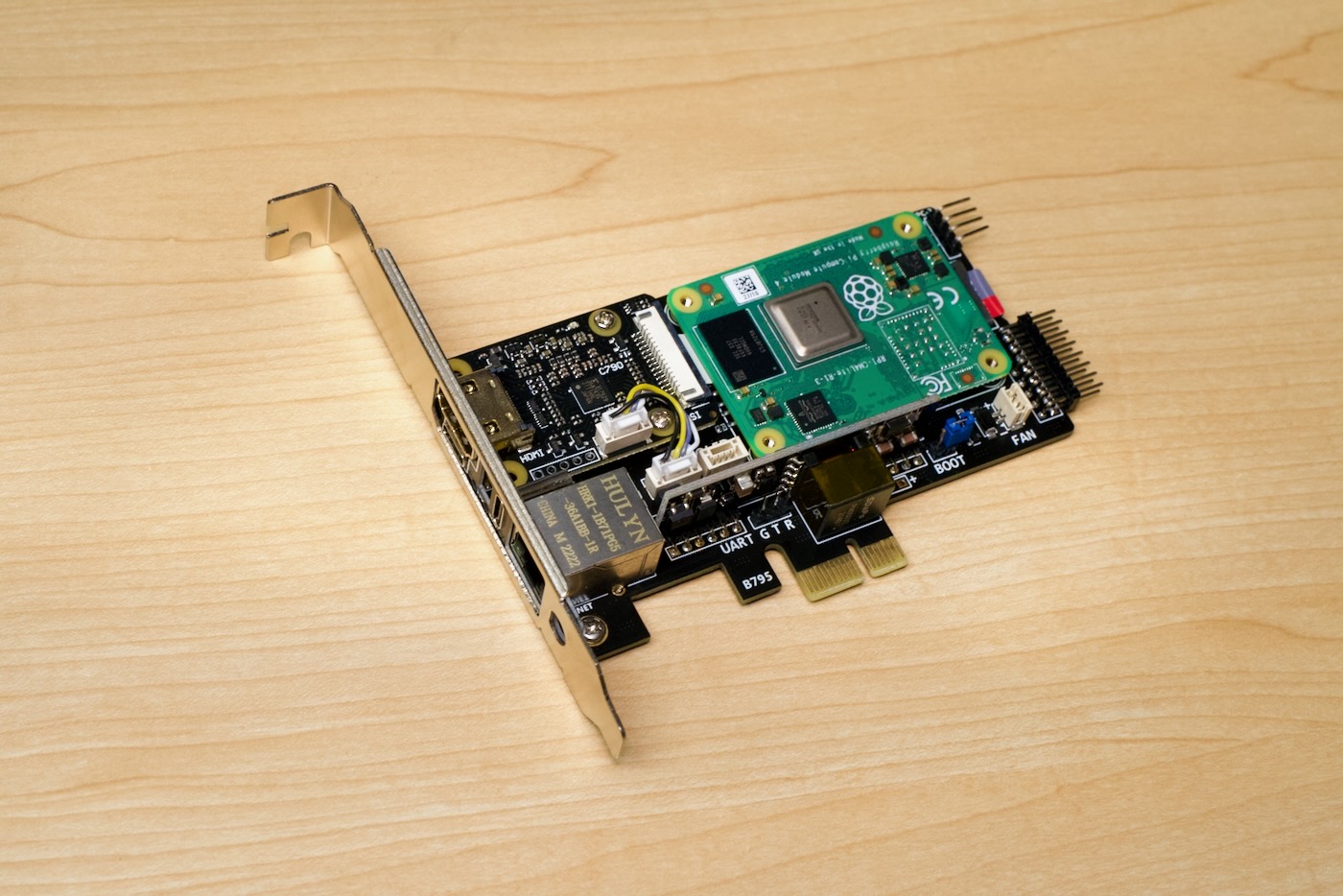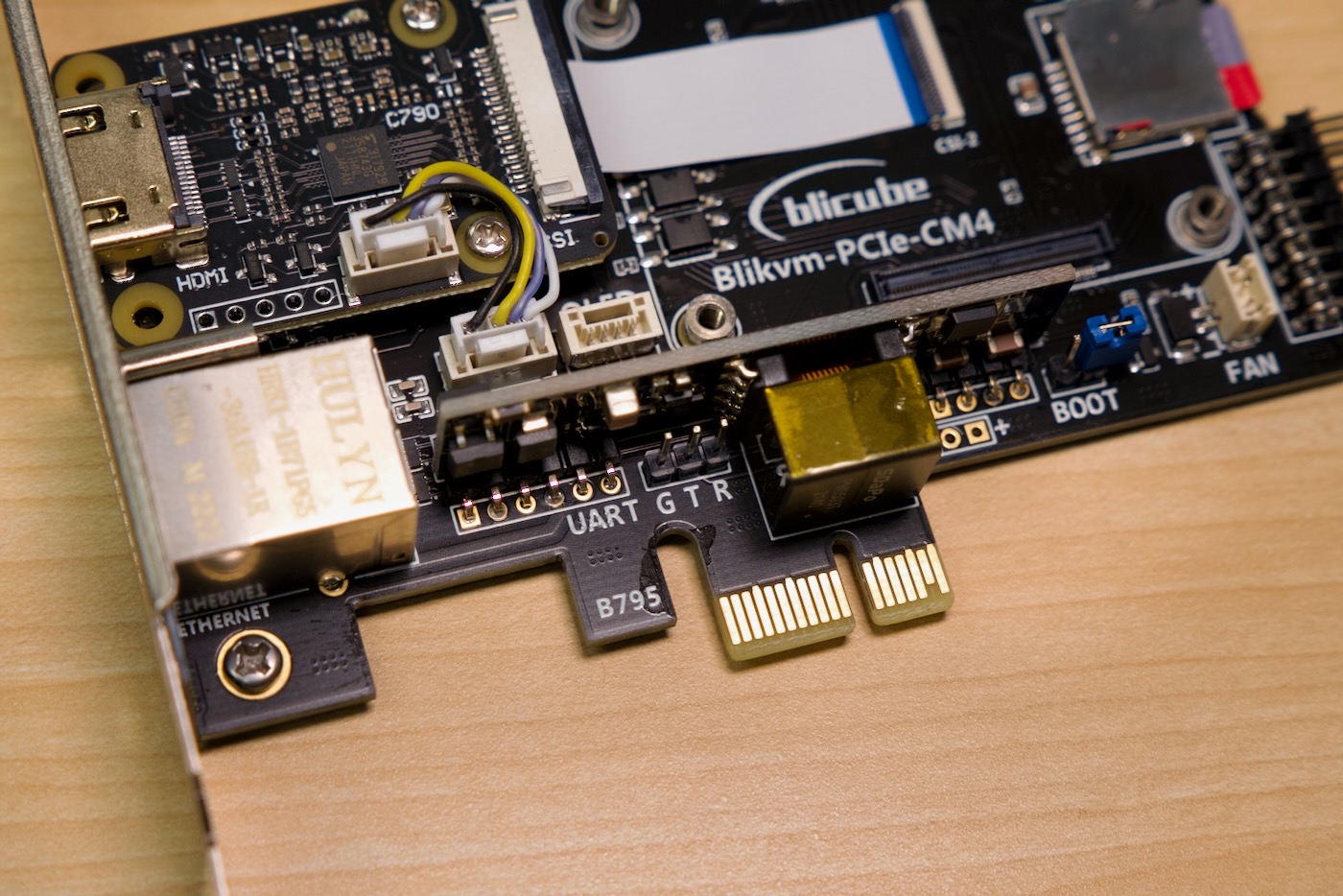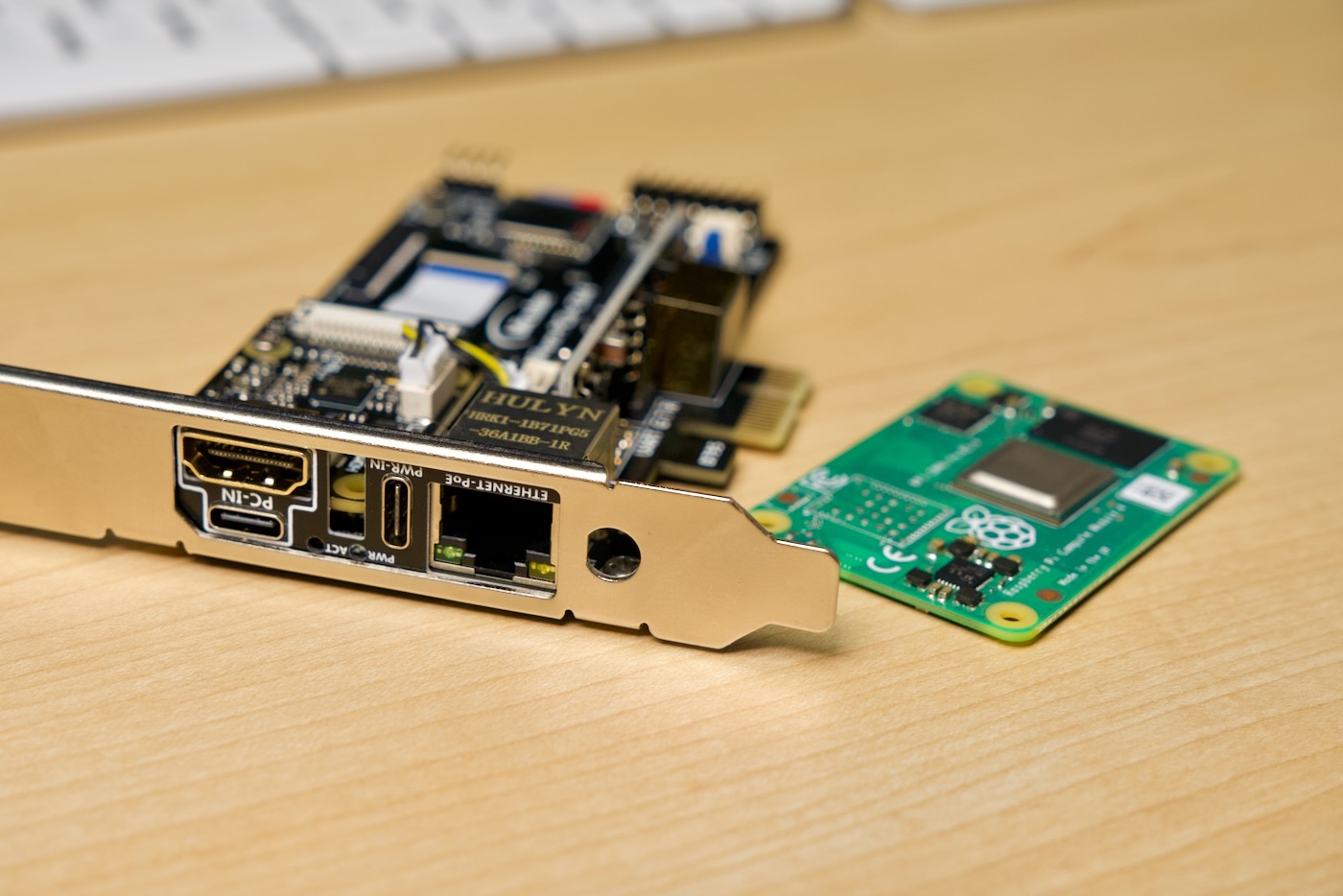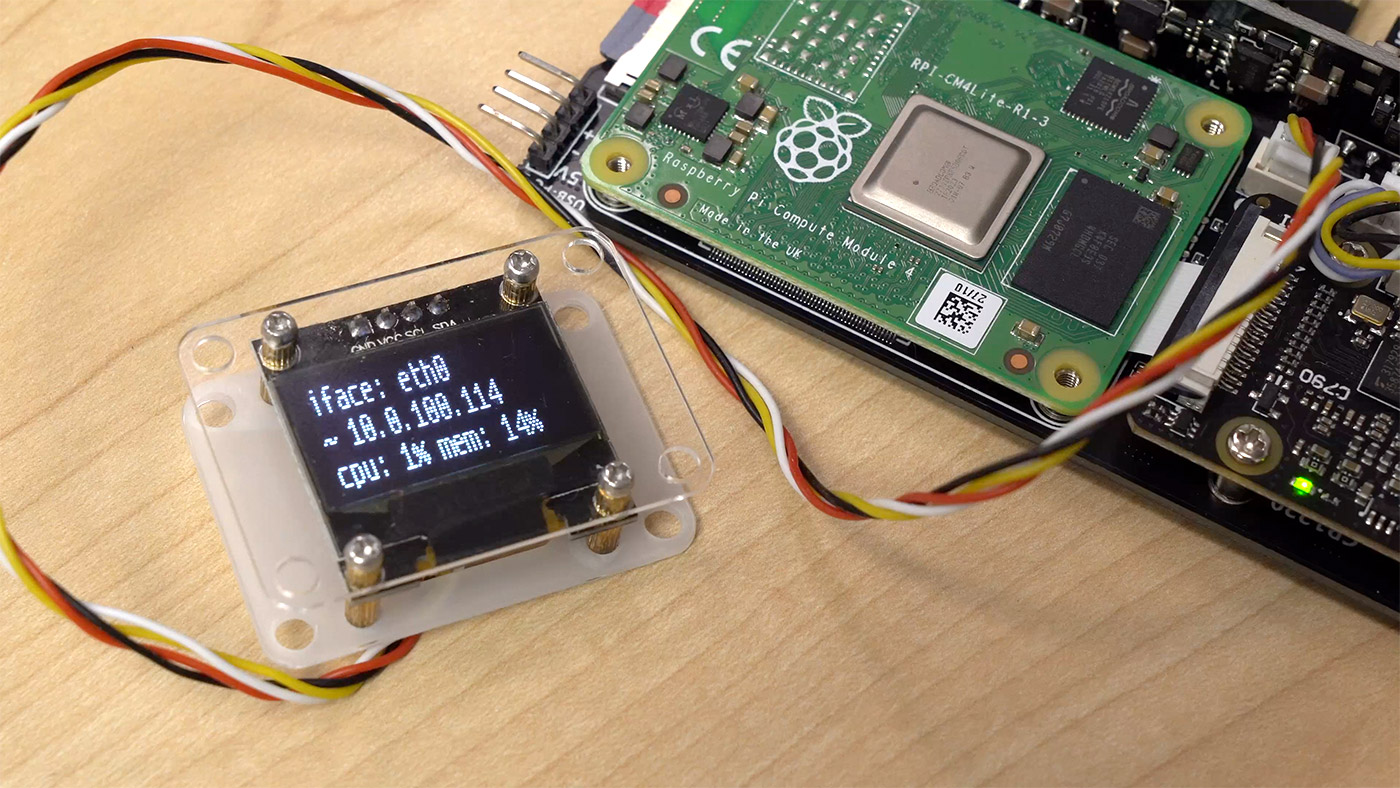
This is the BliKVM PCIe, a full computer on a PCI Express card. This is an IP KVM (Internet Protocol Keyboard-Video-Mouse) that can be put inside another computer or server.
Most server motherboards already have remote 'lights-out' management functionality built in. Most frequently this is referred to as IPMI (Intelligent Platform Management Interface, but Dell calls it iDRAC, and HPE calls it ILO.
But not all servers have it. And even if they do, sometimes you have to pay extra money to use it, or the version you have goes unmaintained and it would be a security risk to keep it running on your network.
So that's where the BliKVM PCIe comes in.
It runs open source software called Pi-KVM, and once it's installed, it can control everything, even if the computer's powered off!
You can boot up the computer and force shut it down. You can remote control it anywhere along the boot process, so you could even manage BIOS settings or install an operating system.
Setup
But how does it work? I mean, it's a PCI Express card. Won't it shut off when you shut down the computer?
Well that's where it gets a little weird.

See these pins? The only ones connected to anything are actually the ground pins. All the data pins are disconnected.
So this card is a PCI Express card... but not really. It uses the slot as a convenient place to mount itself inside a PC or server, so you don't have a Raspberry Pi dangling off the back.
Exposed to the back of the computer is an HDMI and USB input, some activity lights, a USB-C power input, and a Gigabit Ethernet port, capable of using Power over Ethernet to power the device. So technically you could skip the USB-C power plug if you have PoE.

But the heart of this card goes on top—a Raspberry Pi Compute Module 4, a whole computer on a tiny system-on-module board.
blicube (makers of BliKVM PCIe) supplies a lot of accessories in the box, including a heatsink and fan, so if your case has poor airflow, you can get more air to the Pi so it still stays cool.

There's also an OLED display that will tell you the IP address of PiKVM, and other stats like CPU and memory usage.
The front of the board has two headers: one for an internal USB 2.0 connection, and another for front panel ATX IO connections (power, reset, and LEDs).
You can see how I installed it in my desktop tower PC, and how PiKVM's UI works, in my latest YouTube video:
Conclusion
This thing isn't for everyone. Remote Desktop or VNC is adequate for simple remote access. And dedicated apps like Parsec are better if you need low-latency remote access. But if you need full remote access with lights-out management, and you don't have IPMI/iDRAC/ILO already, this is a great option. It's a little expensive, but a lot cheaper than most external IP KVMs.
And with a base model CM4 it's cheaper than ASRock Rack's PAUL card. The BliKVM PCIe can be powered over Ethernet and has a few more external IO options, but the PAUL has a few more internal options for full-fledged servers, like internal sensors and SMBus monitoring for server power supplies.
These types of cards aren't the only reason you might put a computer in your computer, either. Sir Neggles on twitter got this Mikrotik DPU, which is basically a dual 25 Gigabit router-on-a-board, running on a Raspberry Pi too! Granted, it only got 3 Gbps of throughput on the Pi.
A few other things I didn't mention earlier: the BliKVM also comes with a bundle of helpful accessories like a VGA to HDMI adapter, an HDMI Sink for locking in an HDMI resolution, and a low profile bracket, for smaller PC cases and shorter 2U servers.
It uses about 2-3 Watts at idle, and 4-6 watts when you're remoted in controlling the screen. The latency is in the 100-300 millisecond range, so this isn't great for remote gaming, but it's fine for most other use cases. You can get up to 1080p at 60Hz with it.
You can buy the BliKVM PCIe from AliExpress for a little over $100 without a Pi, or they even sell a kit with a marked-up CM4 for a little over $200. BliKVM sent me the card I reviewed in this post, but they didn't pay me anything and had no say about the content in this review.
For the best value, I would recommend getting the version without a Pi, then watch rpilocator until you find one at list price.
I also should mention Pi-powered IP KVM competition like the TinyPilot Voyager 2 and the Pi-KVM v3. I reviewed older versions of those last year, in my video Control ANY COMPUTER with these Pi KVMs!. Also my Dad and I reviewed the original BliKVM that was based on a Raspberry Pi 4 over on Geerling Engineering.
Comments
Thanks, Jeff for pointing out and testing an interesting product.
Unfortunately, within 24hrs of posting the article the product is no longer available either on Aliexpress nor at the manufacturers online store.
Btw: same is true for ASRock Rack's PAUL card that has been unobtainium for the better part of a year.
I was gonna set up a Pi to control the on/off and restart buttons inside my pc...this seems like the perfect device for my needs as it has the hdmi input for bios control too. Awesome:D
And it's sold out on AliExpress.
Man, this would've been such a good product but, like what you've mentioned, it's basically impossible to get my hands on a cm4
Well I just received my two from AliExpress (including a couple of Pi 4s)
Have you tested running different Operating Systems while still using this adapter? It seems like the easiest way to have a pi in an ATX system.
This is a cool gadget for PC overclocking. No longer have to be tied to the rig to start/end/monitor tests. Can also run ISOs like Memtest from Pi-KVM, awesome!
Great recommendation Jeff, this is a very neat little product. I ordered one after seeing your video. It was sold out very quickly but they placed me on a waiting list after paying $10 or so through Paypal. After a week or two I got a link to AliExpress to order and a discount with the same amount as previously paid.
Received the product last week and installed it into my Unraid server yesterday. Works like a charm!
It's great that now I can poke around on my Unraid server without having to attach a keyboard to it or switch displayport cables from my monitor to it. Great improvement!
If you install it, make sure to also check out the PiKVM manuals and you do a systems upgrade (pacman -Syu) and change all the default passwords!
I ordered one to use with my own CM4 that I managed to find in AU and ship over here. I can't seem to get it to boot or show up on the network. I think that the issue is that because mine has onboard memory, it's trying to boot from that as opposed to the included SD card.
I think I have two options. I can either try and find a CM Lite, or I can get the IO Board and try and flash the OS from the SD card to the onboard memory. I may also just be able to set the boot order so that it goes to SD Card first.
Has anyone else had this issue or have any clever solutions? The IO Board path may be a bit above my skill level, but I can certainly mess with it until I figure it out.... Just hunting for ideas I may not have had yet.
Hey I had mine recently and Im having the same issue. Tried booting with bliKvm and Pikvm and both wonth boot after flashing it to RPI Imager...I got a cmlite CM4 so the flashcard is the only way to go. But Im unable to boot from the SD card. Did you find a solution?
Would you recomend Bli's iso's or just installing from base piKVM?
BliKVM's ISO will come with all the little settings correct out of the box. But either is fine.
I bought the BlikVM PCIe as well.. But instead of using the Rasp CM4 module. I will try to use the pin compatible Banana Pi BPI-CM4 card.. It should work I think... I keep you posted Jeff!
See the Banana Pi forum for more info of what I mean: https://forum.banana-pi.org/t/banana-pi-bpi-cm4-computer-module-with-am…
So, did that work?
Hi. Mind elaborating on what image you used for this?
Hello, Please anyone can help me ? i have sent many mail to Support but no reply
I thought may be anyone else can help me ,
Most of the time have wifi only as a connectivity option, we need a solution for reliable connectivity for BLIKVM as a fellow
BLIKVM should ping any defined IP example 8.8.8.8 and connect to WIFI SSID A, If 8.8.8.8 is not pingable from WIFI SSID A, it should connect to the next saved SSID after the defined time example next Wifi SSID is B and if 8.8.8.8 is also not reachable from SSID B, it should move to next saved wifi SSID.
Thanks in advance
Would it be possible to just saw off the PCIe connector then? Some ITX/mATX motherboard don't have a lot of PCIe connectors available, and some put a NVMe socket in lieu of said connectors. In my case, the SFF PC I'm using has some unused brackets in the back, and there would be room for the BliKVM except that my boot NVMe is in the way.
I wonder this too. Any ideas?
BliKVM CM4 PCIe can be connected to the network together with a 10 glan card or it must be connected only via BliKVM CM4 PCIe